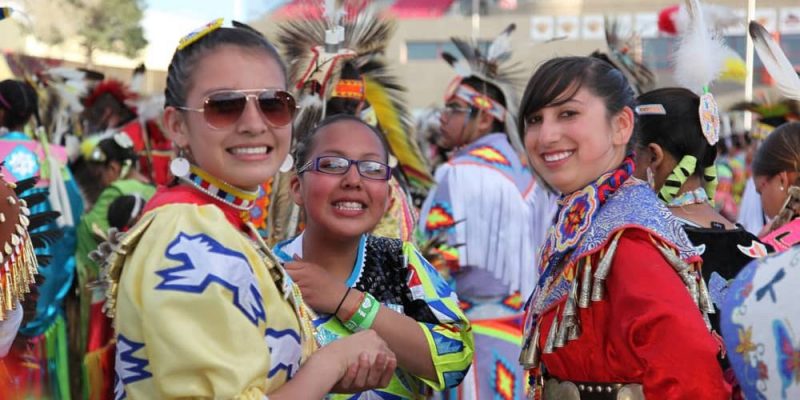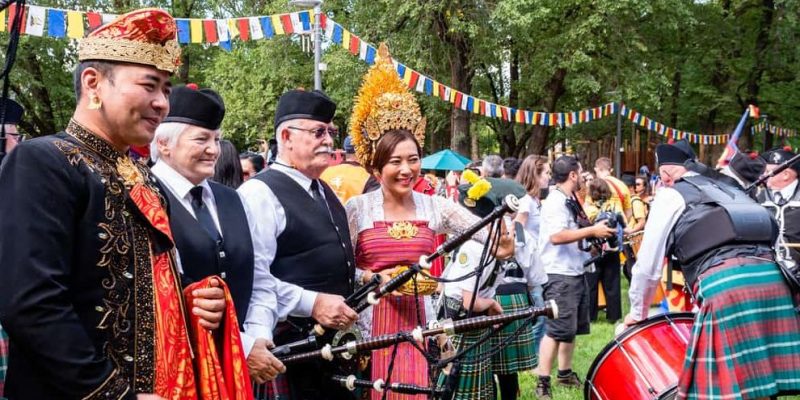We explain what cultural diversity is, its types, its importance and various examples. Also, the cultural diversity in Mexico.

What is cultural diversity?
Cultural diversity is variety and coexistence of different cultures within a society, a region or the entire world. It includes diversity of languages, traditions, customs, religions, arts, gastronomy and other elements that differentiate the various cultural groups.
The concept of cultural diversity arose within the framework of the struggle of the different civil rights movements against oppression, racial discrimination and cultural marginalization imposed by colonial and racist systems. Today, it constitutes a fundamental value because promotes equality, mutual respect and inclusion in increasingly globalized and interconnected societies.
Currently, cultural diversity is defended by international law through UNESCO's Universal Declaration on Cultural Diversity and the Convention on the Protection and Promotion of the Diversity of Cultural Expressions, which establish the norms and principles for its recognition and defense at a global level.
Frequently asked questions
What is cultural diversity?
Cultural diversity is the coexistence of different cultures, traditions and practices within a society.
What is respect for cultural diversity?
Respect for cultural diversity implies recognizing, valuing and protecting cultural differences, promoting equal rights and harmonious coexistence between different groups.
Why is cultural diversity important?
Cultural diversity is important because it enriches societies, promotes intercultural understanding, encourages creativity and contributes to economic and social development.
What are the international laws on cultural diversity?
The most important international laws on cultural diversity are the UNESCO Universal Declaration on Cultural Diversity and the Convention on the Protection and Promotion of the Diversity of Cultural Expressions. Both seek to protect and promote cultural diversity at a global level.
Importance of cultural diversity
Cultural diversity is a fundamental value in building a peaceful future for humanity. Promotes intercultural understanding and tolerance which reduces conflicts based on prejudices and stereotypes.
By valuing and protecting cultural diversity, Societies can build a more inclusive and equitable future where individuals have the opportunity to thrive in an environment that celebrates and respects their cultural identities.
On the other hand, cultural diversity enriches the human experience by offering a wide range of perspectives, knowledge and practices. In this way, unique traditions that reflect the history and identity of different ethnic groups and communities are preserved and transmitted.
Types of cultural diversity

Cultural diversity covers a wide variety of aspects that reflect the differences between different human groups. Some of the main types of cultural diversity are:
- Linguistic diversity. It consists of the coexistence of different languages or dialects.
- Religious diversity. It involves the practice of different religions, belief systems or spiritual traditions.
- Ethnic diversity. These are variations in ancestry, ethnicity, and physical characteristics of the people who make up a community or society.
Examples of cultural diversity
Cultural diversity is expressed through different practices around the world. Some illustrative examples are:
- Linguistic diversity in India. Hundreds of different languages and dialects are spoken in India. Hindi is the official language, but each state and region has its own primary language, such as Bengali in West Bengal, Tamil in Tamil Nadu, and Gujarati in Gujarat. This linguistic diversity reflects a rich cultural history and allows different ethnic and regional groups to celebrate their cultural linguistic identities.
- Religious diversity in Malaysia. In Malaysia, the religions of Islam, Buddhism, Hinduism and Christianity coexist, as well as other belief systems. This religious diversity is manifested in the architecture of places of worship, in ritual practices and religious festivals, and in the social customs that define the daily life of the population.
- Ethnic diversity in South Africa. South Africa is a country of great ethnic and racial diversity, with a population that includes groups such as Zulus, Xhosas, Afrikaners and whites of European descent, as well as Indian communities and other ethnic minorities. This diversity has shaped the country's history and culture, influencing its politics, art and traditions.
Cultural diversity in Mexico

Mexico is one of the countries with the greatest cultural diversity in its territory. It integrates populations that speak more than 65 different dialects or languages, distributed in more than 25 cultural regions. The Mexican nation encompasses 68 towns of different ethnic origins.
This great diversity gives Mexico an extraordinary historical, religious and linguistic plurality, manifested in different popular and folkloric traditions, in a particular culinary richness and in a unique tourist potential in the region.
In 1992, through a State decree, the multicultural character of the nation was officially recognized and to the various indigenous peoples who live there.
In 2001, Mexico signed UNESCO's Universal Declaration on Cultural Diversity. Later, the Mexican constitution was reformed and integrated formal recognition of the multicultural nature of the Mexican State.
In 2003, the General Law on Linguistic Rights of Indigenous Peoples was approved, through which the General Education Law was reformed to highlight the national value that constitutes their particular cultural heritage.
History of cultural diversity
The concept of cultural diversity emerged in the mid-20th century in response to oppression, racial discrimination and cultural marginalization imposed by colonial and racist systems.
During and after decolonization, civil rights movements around the world began to highlight the importance of recognizing and valuing different cultural traditions to combat injustice and promote equality. They fought against the imposition of dominant cultures and defended the right of people to maintain their own cultural identities.
The Universal Declaration of Human Rights of 1948 had laid the foundations for equality and non-discrimination and civil movements relied on these principles to consolidate their struggle. In the 1960s and 1970s, recognition of cultural diversity gained momentum with growing awareness of human rights and social justice.
In 1982, these movements achieved the Mexico Declaration on Cultural Policies of UNESCO, which established the fundamental principles for the protection and promotion of cultural diversity at the international level.
Finally, in the 21st century, the importance of cultural diversity was formally recognized at the global level with the adoption of the Universal Declaration on Cultural Diversity in 2001 and the Convention on the Protection and Promotion of the Diversity of Cultural Expressions in 2005 by UNESCO.
Concepts linked to cultural diversity
The defense of cultural diversity is related to other fundamental concepts that cross different social groups. Among them, the following stand out:
- Interculturality. It refers to the process and practice of interaction between people or groups of different cultures. Interculturality seeks to facilitate mutual understanding, cooperation and exchange between different cultures, promoting intercultural dialogue and the construction of more inclusive and cohesive societies.
- Pluriculturality. It refers to the coexistence of multiple cultures within the same country or society. This term highlights cultural diversity as an inherent and fundamental characteristic of national identity.
- Multiculturalism. It involves the interaction and coexistence of diverse cultures in a social environment. This term emphasizes the active coexistence and interaction between different cultural groups within a society.
- Cultural minorities. It refers to groups within a society that share a distinct cultural identity and may face challenges in terms of recognition, rights and access to resources compared to the dominant culture.
- Acculturation. It is the process by which a group adopts the cultural characteristics of another dominant society, due to the prolonged asymmetric interaction between both groups. It is a consequence of cultural oppression and the marginalization of subjugated cultures.
- Cultural heritage. It includes material and immaterial goods that are inherited from generation to generation within a community, reflecting its history, traditions and values.
- Cultural adaptation. It refers to the process by which individuals or groups adopt practices, norms and values from a culture different from their own. It is the result of the balanced interaction between different cultural groups and globalization.
document.addEventListener(“DOMContentLoaded”, (e) => {
var sliderContainer, slider;
sliderContainer = document.getElementById(‘block_5b420db83f2900b37bbfb0c1d4597c9f’);
if (typeof initSlider !== ‘function’) {
console.log(‘Swiper haven\’t been loaded’);
sliderContainer.className += ‘ fw scroll-snap’;
return;
};
options = {
direction: ‘horizontal’,
speed: 1000,
slidesPerView: ‘auto’,
// slidesPerGroup: 1,
centerInsufficientSlides: true,
// centeredSlides:true,
spaceBetween: 15,
breakpoints: {
720: {
// centeredSlides: false,
// slidesPerGroup: 2,
spaceBetween: 25
},
},
pagination: {
el: ‘.swiper-pagination’,
type: ‘bullets’,
clickable: true
},
}
slider = initSlider(sliderContainer, options);
})
References
- Eagan, J.L. (2024). Multiculturalism. Encyclopedia Britannica. https://www.britannica.com
- Logan, W., Langfield, M., & Craith, M.N. (2010). Intersecting concepts and practices. Cultural Diversity, Heritage and Human Rights. Intersections in Theory and Practice. Routledge.
- Song, S. (2020). Multiculturalism. The Stanford Encyclopedia of Philosophy. https://plato.stanford.edu
- UNESCO. (2005). Convention on the Protection and Promotion of the Diversity of Cultural Expressions. https://www.unesco.org
- Zolla, C and Zolla Márquez, E. (2004). The indigenous peoples of Mexico. 100 questions. National Autonomous University of Mexico. https://www.nacionmulticultural.unam.mx





